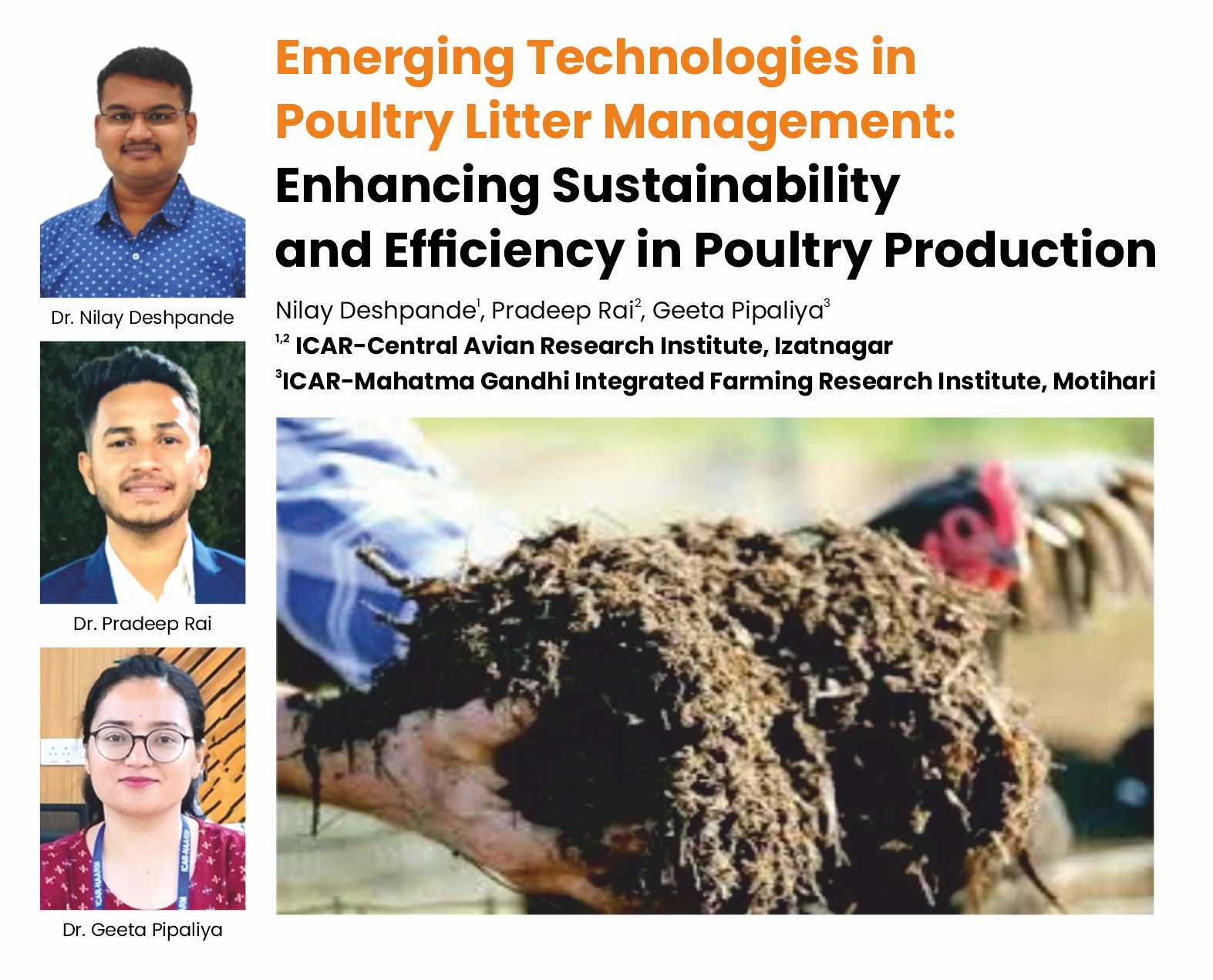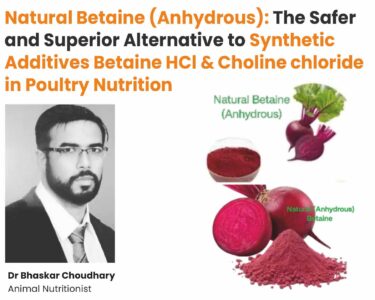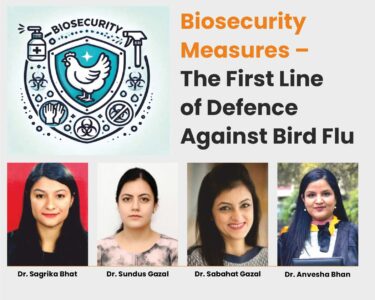Emerging Technologies in Poultry Litter Management: Enhancing Sustainability and Efficiency in Poultry Production
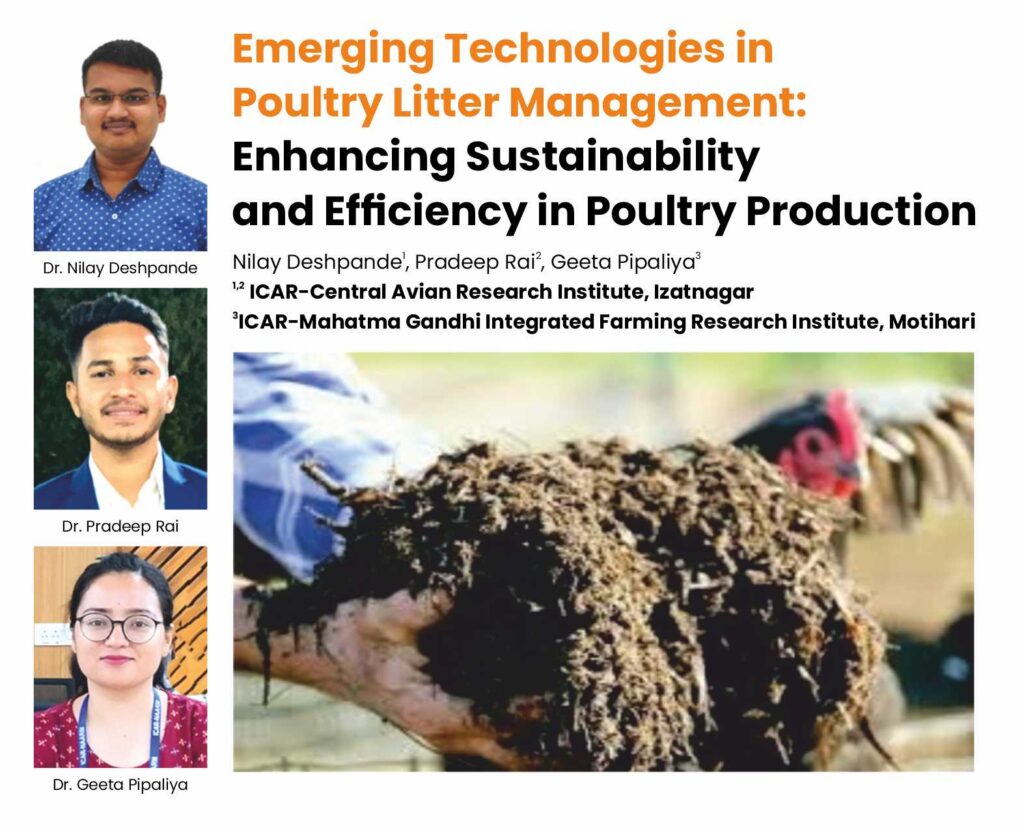
Efficient poultry litter management for broiler chicken farms is essential for maintaining bird health, ensuring farm profitability, and protecting the environment. One key tool in this effort is the Poultry Litter Decision Support System (PLDSS), which outlines a five-step plan for effective litter management. Additionally, a temperature prediction model can aid in litter pasteurization, further enhancing its efficacy. Innovative technologies such as electronic noses and AI-powered robots are being employed to address challenges related to odor control and litter management tasks. Moreover, the use of artificial turf flooring is showing promise in improving air quality within laying hen houses.
Keywords: Poultry litter management, PLDSS, litter pasteurization, e-nose, AI robots, artificial turf flooring
The poultry industry’s phenomenal growth creates a critical challenge: managing the vast amount of poultry litter, a mix of manure and bedding materials. The intricate interplay among the poultry industry’s worldwide impact, technical advancements, and the urgent demand for innovative approaches to litter reduction are significant factors compelling us to consider litter management.
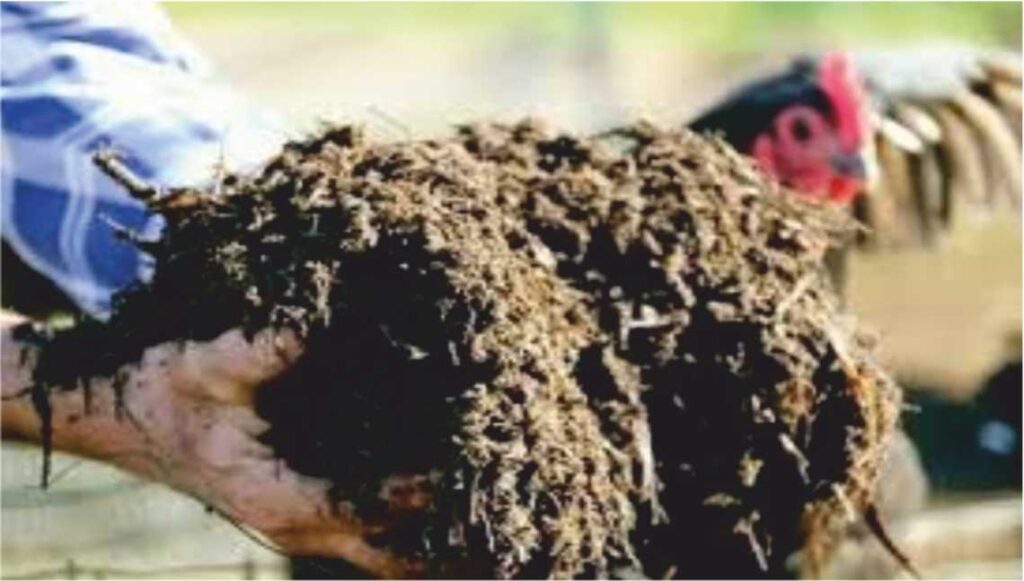
With the United States leading the way in broiler production, the global output reached a staggering 101.2 million metric tons in 2021.This exponential growth necessitates sustainable practices to handle poultry litter efficiently. As the poultry industry continues to expand, effective waste management becomes paramount.
The amount of chicken manure produced globally is astounding. The amount of broiler meat produced in 2021 was estimated to be 101.2 million metric tons; by 2023, that amount is expected to increase to 103.4 million. About 1.1 to 2.4 MT of dry manure, 7.3 to 12.7 MT for turkeys, and 3.9 MT for ducks are produced by 1000 birds raised to market age on commercial farms. 9486 MT of hatchery waste, 1.74 million MT of slaughterhouse waste, and 38.33 million MT of chicken manure were produced in India in 2018–2019. To properly manage the waste from poultry, this exponential growth calls for sustainable practices.
Not only is efficient litter management important for the environment, but it’s also essential for farm productivity and animal welfare. Litter management that is done right enhances bird health, productivity, and profitability. However, poor handling can result in disease outbreaks and significant financial losses.
Poultry Litter Decision Support System (PLDSS)
Applying chicken manure to row crops and pastures is an inexpensive substitute for synthetic fertilizers. Because of the high P to N ratio in chicken litter, applying it in accordance with the agronomic N requirements of the fodder has over time led to a buildup of P in the soil. P runoff can hasten eutrophication, which can seriously degrade water bodies that support aquatic, recreational, and drinking water uses, despite P being a necessary nutrient for plant growth. There are numerous definitions for a DSS. But it can be thought of as an interactive, adaptive, and flexible computer-based information system designed specifically to help identify and resolve a complex, poorly organized, or unstructured.
The Poultry Litter Decision Support System (PLDSS) is a comprehensive five-step management plan that begins by estimating farm-produced poultry litter and compost, assessing their nutrient content for proper application. It then identifies suitable land for spreading, aligns application with crop nutrient needs, and manages excess litter by exploring responsible disposal options. Over time, the PLDSS can create a database to aid research on non-point source pollution and inform businesses about surplus litter for value-added products, offering a holistic view of poultry litter management challenges.
Litter Temperature Prediction Model & Pasteurisation Decision Support Tool
The model was created using a data set that included 542 temperature profiles taken at different depths during a litter pasteurization cycle that lasted six to ten days in about 100 litter heaps that were treated on eight farms. There are more than 90,000 distinct temperature records in the data collection. Using 75% of the data for development and 25% for validation, an empirical model of the dataset was created.
As part of the chicken CRC project Methods to quantify and inactivate viruses in chicken litter, a litter temperature prediction model and a pasteurization decision assistance tool were created. The tool’s parameters are listed in the following. Purpose of this tool is to forecast temperatures and offer user-defined summary temperature data for poultry broiler litter that has been heaped for pasteurization.
A sectional heat map of the heap/windrow at a given time with a table showing the percentage of the heap in different temperature classes, average, minimum, and maximum heap temperatures, the proportion of the heap/windrow reaching specified temperatures and durations, and temperature profiles at specified depths.
Animal Waste Management Software
Software for animal waste management (AWM) is a tool for planning and designing projects that supports the calculations needed for manure management systems. Lagoon, storage pond, storage tank, and stacking facility design is supported by the expected daily production of manure, bedding, and process water. Average monthly precipitation and evaporation statistics are utilized in the AWM methods and computations, which are based on data from the AWMFH. Additionally, the program encourages the design of multiple-cell anaerobic and aerobic lagoons that can be used alone or in conjunction with other manure storage facilities. Users of the program can produce preconfigured reports for design, operation, and maintenance. Design variables that are integrated into the report templates can be used to create customized reports. Manure Master, a streamlined tool for calculating the amount of cropland required to create the nutrients generated by an animal feeding operation, is also included in AWM. The nitrogen, phosphorous, and potassium content of the manure and the amount of these nutrients utilized by crops are combined to create a gross nutritional balance that is calculated by Manure Master. This balance can be calculated based on known recommended fertilizer application rates, or it can be estimated based on the nutrient content of the plant. The nitrogen balance is calculated with the expected losses from leaching, denitrification, and volatilization.
Artificial Turf Floor
Artificial turf flooring has the potential to significantly improve the air quality in laying hen houses, according to studies. Artificial turf drastically lowered ammonia, carbon dioxide, and particle sizes when compared to regular wood shavings. The reasons for this progress are several. First off, artificial turf reduces ammonia generation directly by preserving more nitrogen and lowering the pH of manure.
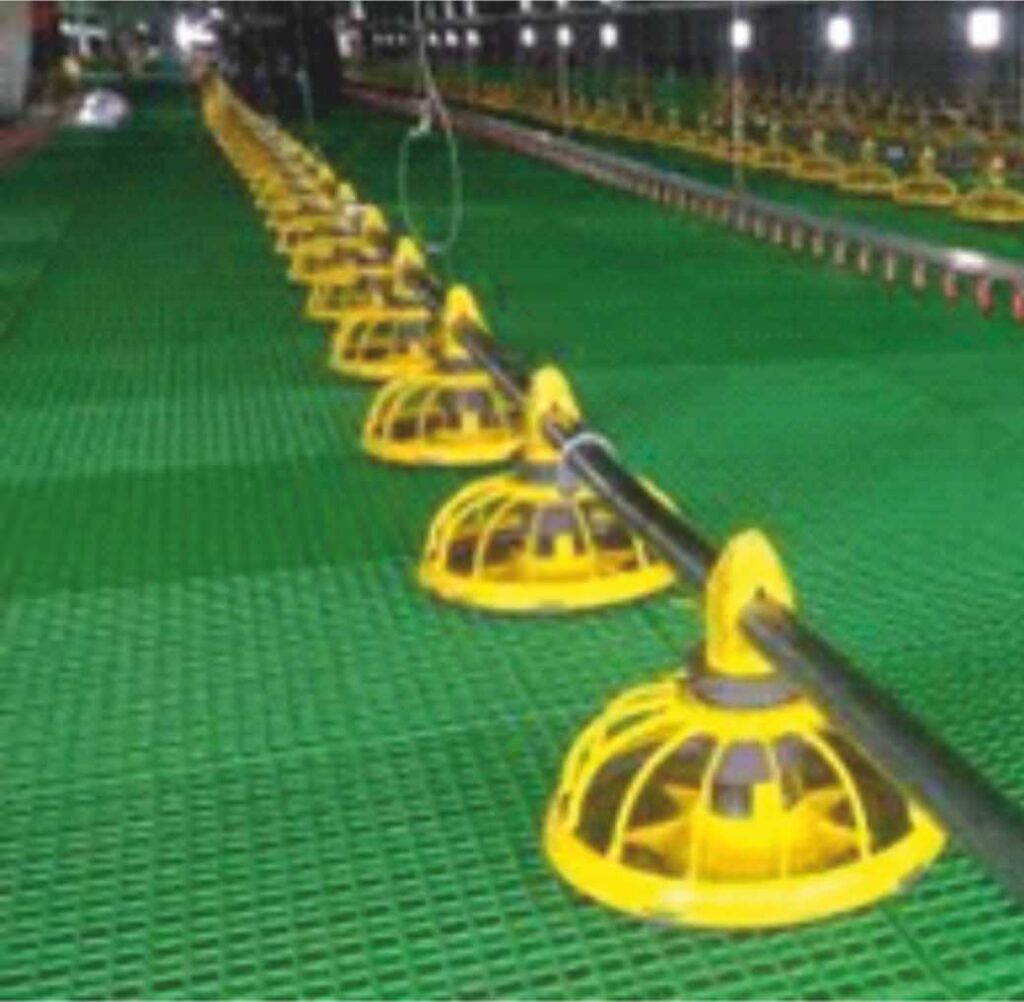
Secondly, by reducing sources on the floor where hens interact, the turf itself lowers airborne particulate pollution. Lastly, it appears that artificial turf affects airflow patterns, which results in a more uniform gas distribution and a decrease in concentration gradients inside the housing. It’s vital to remember that proper comparisons of air quality between various flooring types depend on maintaining stable and regular ventilation rates.
Electronic Nose
Effective poultry litter management involves addressing odor issues associated with poultry waste. Traditional olfactometry, while valuable, can be costly due to sample collection and analysis expenses. To overcome these limitations, electronic noses (e-noses) offer an affordable and real-time alternative. E-noses detect volatile organic compounds (VOCs) linked to odors, providing accurate measurements. Integrating e-noses alongside traditional methods allows poultry farmers to make informed decisions, minimize odors, and maintain a healthier environment for both birds and humans.
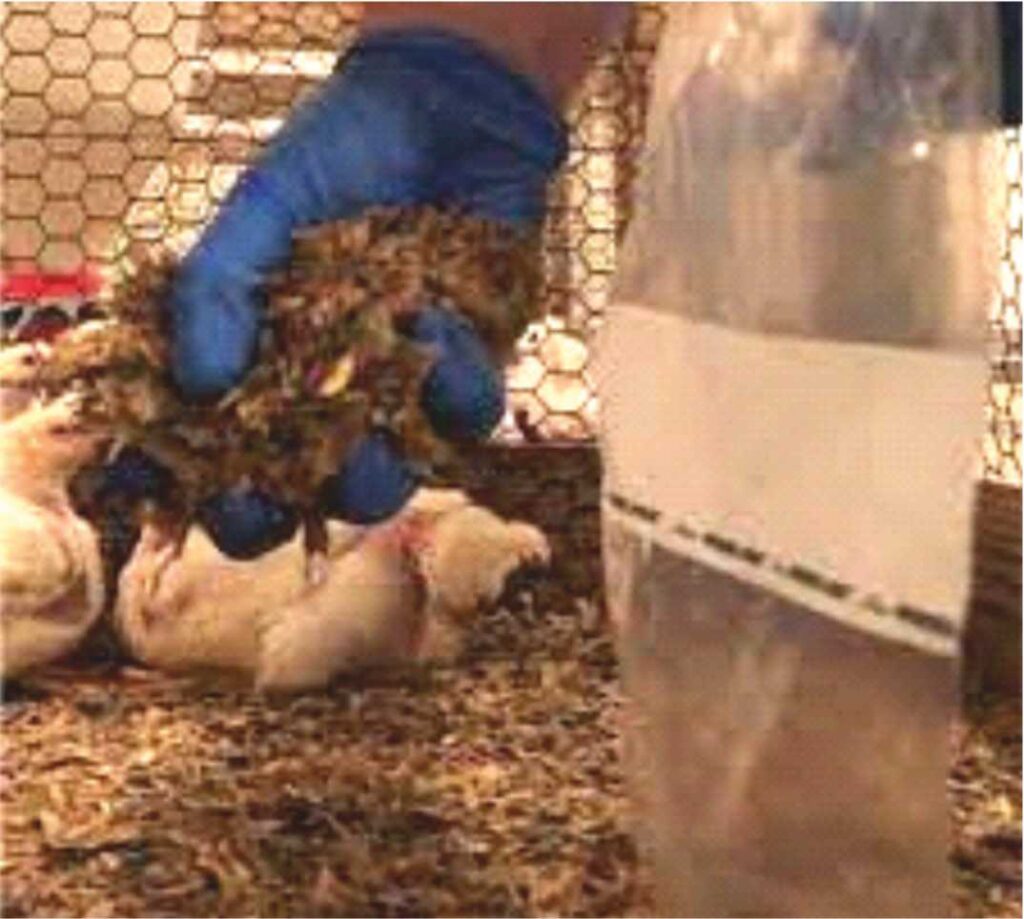
AI-Powered Robots for Litter Management
Numerous businesses have created robots to assist in managing the litter in broiler homes for chickens. For instance, Octopus Robots, a French business, has introduced two fully autonomous robots, one of which is intended to turn and aerate chicken bedding. A different business, Metabolic Robots, has developed a robot that can oversee, measure, monitor, and regulate operations on chicken farms. These robots can grind, mix, aerate, tilt, decake, scare, and pulverize poultry litter. The effectiveness of litter management in chicken broiler houses can be increased with the employment of these robots.
The AI-driven autonomous robots are meant to clean the litter in chicken broiler houses. It has a scarifier installed to aerate the litter once a day, preventing crusting and enabling reduced ammonia levels. In the chicken shed, the robot is also capable of gathering data on temperature, humidity, and ammonia levels. AI-powered robots can not only scarify the litter but also carry out other duties like drying the litter, preventing scab development, lowering ammonia generation, distributing sanitizing solutions, and cleaning the litter by misting sanitizing solutions. The robot has the ability to administer local adaptive therapy and disperse itself as near to the target as it can.
Robots using artificial intelligence (AI) are useful and effective technologies for controlling litter in chicken broiler facilities. Their capacity for multitasking on their own can enhance litter control effectiveness and promote a healthier environment for the chickens. Emerging technologies offer a beacon of hope. Precision livestock farming and waste-to-energy processes are just a few examples of innovative solutions that can minimize environmental impact, enhance resource utilization, and safeguard animal and human health.
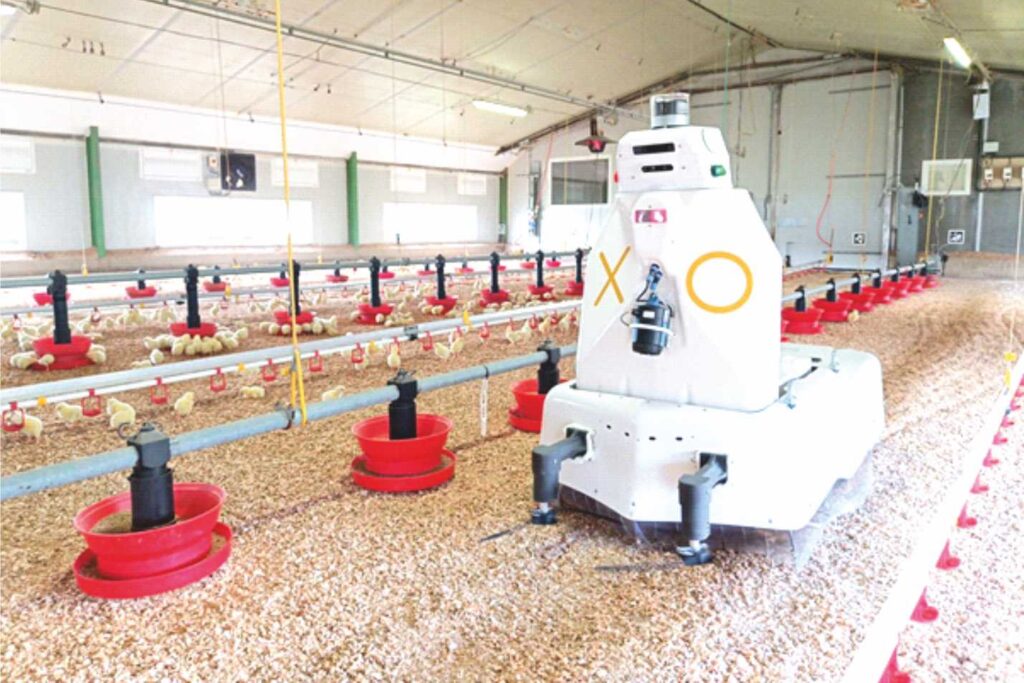
References : Sohn, J. H., Hudson, N., Gallagher, E., Dunlop, M., Zeller, L., & Atzeni, M. (2008). Implementation of an electronic nose for continuous odour monitoring in a poultry shed. Sensors and Actuators B: Chemical, 133(1), 60-69. Ren, G., Lin, T., Ying, Y., Chowdhary, G., & Ting, K. C. (2020). Agricultural robotics research applicable to poultry production: A review. Computers and Electronics in Agriculture, 169, 105216. Kelleher, B. P., Leahy, J. J., Henihan, A. M., O'dwyer, T. F., Sutton, D., & Leahy, M. J. (2002). Advances in poultry litter disposal technology–a review. Bioresource technology, 83(1), 27-36. Kang, M. S., Srivastava, P., Tyson, T., Fulton, J. P., Owsley, W. F., & Yoo, K. H. (2008). A comprehensive GIS-based poultry litter management system for nutrient management planning and litter transportation. Computers and electronics in agriculture, 64(2), 212-224.


